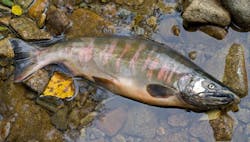Researchers Shine Light On Aquatic Microplastics
Exposure to microplastics has dramatic effects on freshwater systems after just 15 days, say Spanish researchers. The stream ecology group at UPV/EHU-University of the Basque Country, Bilbao, carried out the work in collaboration with the National Museum of Natural Sciences, Madrid, and reported their findings in a recent issue of Environmental Pollution.
“Concern about contamination caused by microplastics is growing. Owing to their abundance, ubiquity and persistence over time, microplastics pose a potential risk for organisms and ecosystems. Yet, studies into their distribution in freshwater systems, in both lakes and rivers, and their effects on the organisms in these waters are few and far between, and there is very little information about their potential effect on the functioning of these ecosystems,” notes stream ecology group researcher Naiara López-Rojo.
Two parallel studies investigated how the larvae of one freshwater amphibian and one invertebrate evolved during 15 days of exposure to microplastics at different concentrations.
[pullquote]
One looked at tadpole survival, food and growth as well as ingestion and egestion of the microplastics. This included analysis of whether the microplastics affect periphyton, the microscopic organisms that make up the main food supply of tadpoles.
The second focused on how microplastics affect the decomposition of leaf litter — one of the most important processes in river ecosystems — and on the detritivore invertebrates that live on it. This included analysis of the microplastics’ degree of attachment to the leaf litter and degree of its ingestion and egestion of the detritivores — and so evaluating the trophic transfer mechanisms of the microplastics.
“The results found that microplastics cause mortality in detritivores in all concentrations and in the highest concentration mortality is nine times higher. In the case of tadpoles, they die in the highest concentration of microplastics. In other concentrations [low and medium] we did not see any lethality, but we did see a reduction in the growth of the amphibians,” López-Rojo explains.
The presence of microplastics in the tadpoles, in their feces and in the periphyton suggests they could be significant stressors for amphibians, she adds. Also, amphibians could be an important transmission channel of freshwater microplastics to terrestrial ecosystems.
In the case of the invertebrates, the tests suggest microplastics were also ingested (very likely through the ingestion of particles attached to the leaf litter) and some of them excreted.
“The more the concentration of microplastics increased, the less the leaf litter decomposed. These results provide fresh evidence of the damaging effects of this contaminant on aquatic life and on the functioning of river ecosystems, and highlight the need to standardize the methods to be used in future experiments on microplastics to be able to draw comparisons,” concludes López-Rojo.
Meanwhile, concern about the potential impact of such particles on the marine environment has prompted the European Commission to limit the use of intentionally added microplastic particles in a variety of chemical substances.
In addition, the European Chemical Industry Council (CEFIC), Brussels, is running two projects designed to provide data for a robust risk assessment on microplastics’ potential impact on the environment and to develop an appropriate way to deal with them.
The first, started in Q1 2019, runs for two years and has a budget of €200,000 ($225,000). It aims to better understand the characteristics, processes and environmental conditions associated with the fate and transport of microplastics to help determine appropriate environmental concentrations and put into context the relevance of hazards from these contaminants.
Additionally, it calls for developing a microplastic environmental fate and transport model that can facilitate risk assessment for different microplastic categories and inform safer chemical development and future sustainability efforts.
The second is a €400,000 ($450,000) three-year two-phase project also started in Q1 2019. Phase one involves a comprehensive literature review to identify both key ecological hazard research gaps and appropriate methods for conducting hazard tests to fill such gaps.
The review, currently underway, focuses on the applicability, adaptability and usage of existing toxicity testing methods for evaluating the hazards of solid polymer materials for representative test organisms such as fish, invertebrates, algae and others identified as potentially sensitive to these particles.
Building on this review, the second phase will involve targeted ecological hazard research to evaluate how both intrinsic and extrinsic factors influence the effects of microplastics on sensitive environmental species.
Seán Ottewell is Chemical Processing's editor at large. You can email him at [email protected].

